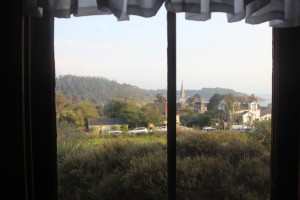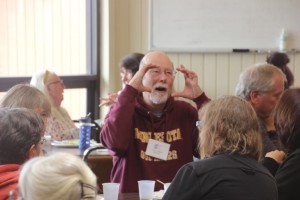I attended Lisa Locascio’s afternoon presentation, “Mapping the Interior; Portraying the Internal Landscape in Prose,” on Thursday.
First, a confession: while I often stay for the faculty readings, I rarely attend the afternoon sessions. I always have good intentions about attending… then I wander off to check out the coastline, get coffee, take pictures of ravens or drift down to the harbor. I go into town. Sometimes I go back to my room and fall asleep, or write something, or sit on my balcony and watch the harbor.
I thought Lisa’s presentation would be about ways to use internal landscape as a metaphor for a character’s thought processes or psychology. It wasn’t exactly that. If I’m pressed to say what it exactly was, I’ll be in trouble, because I don’t really know. There are some things I do know after the session, though. Here’s a list.
- Lisa Locascio is brilliant.
- Lisa Locascio is funny.
- MacArthur Park, by Jimmy Webb is not a good song. It isn’t even a good song ironically.
- Nella Larsen is someone I have to read.
- I think about landscape and interiors differently now.
Locascio talked briefly about the concept of “object permanence;” that if we sit in a room and close our eyes, we believe that the room is still there; the chairs, the walls, the ratty carpet. Object permanence is a developmental phase and it’s not as obvious as you might think. If you doubt that, the next time you are visiting with a friend who has an infant that has become fascinated with your car keys, put them where the baby can’t see them. Then try that same trick with a two-year-old. That’s “object permanence,” the knowledge that things still exist in the world even if we can’t observe them.
She shifted from this into the concept of space. We create space – rooms — in our heads, basically. (By the way, if I’m getting this wrong, the fault lies with me, not Lisa Locascio. Lisa has given this topic a lot of thought and a lot of work.) She used quotes from various works to demonstrate how interiors, mostly, are used to inform a work. She talked about her own internal version of The Annex, from the Diary of Anne Frank. Lisa had a pretty good idea of what the hidden area where Frank and her family hid looked like, even though parts of it looked like her own grandparents’ house in the Midwest. This doesn’t make her mental image any less powerful or accurate, because when she enters that internal room, it brings the correct combination of feeling and mood.
Stories about the Holocaust, and people hiding from the Nazis evoke hidden rooms and secret rooms; we imagine our own version of the hidden room and tap into the feeling and mood. That is also what our writing can do, and should do.
Lisa had us do three writing exercises, the first two about our own personal “inner rooms.”
Probably the gold nugget I took away from Lisa’s session was the introduction of Nella Larsen, who wrote Quicksand and Passing. Larsen was of African American and Danish descent, a voice in the Harlem Renaissance, and I had never heard of her. Lisa introduced her by reading a description of an interior in Larsen’s Quicksand. The description is beautiful and precise, simply by describing the light, the table, the flowers and the chair Larsen shows us how this room is a refuge, a sanctuary for the character.
Taking us from the sublime to the somewhat ridiculous, Lisa then walked us through the history of that 1960s classic, MacArthur Park. No, really. I mean, it is about a landscape… right? Then she played the Richard Harris version, and had us write to it. For seven and a half minutes. Yes, she did.
I don’t want you to feel left out, so here is a link to Richard Harris singing about cakes melting in the rain and old men playing checkers. Go ahead, do a timed writing to it. You know you want to!
Before we did that she took questions. As you might expect many of the participants were in her workshop. I was impressed with the intelligence and generosity of her answers. I would guess her workshoppers felt very encouraged and supported in her workshop space.



